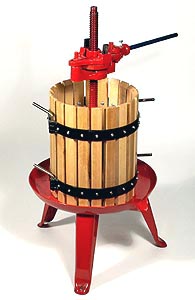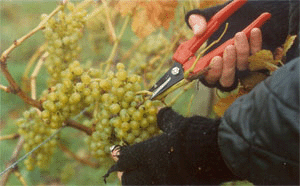 If you have never made wine at home before, don't panic, it's not difficult. You don't have to worry about all the 'science' that goes into commercial winemaking - unless you really want to! Getting hold of the necessary winemaking raw materials is usually straight forward enough - but, to save you time and effort, I have made it easy for you to source virtually everything you'll need right from this site, from wine and winemaking 'how-to' books to a great efficient, time saving fruit press.
If you have never made wine at home before, don't panic, it's not difficult. You don't have to worry about all the 'science' that goes into commercial winemaking - unless you really want to! Getting hold of the necessary winemaking raw materials is usually straight forward enough - but, to save you time and effort, I have made it easy for you to source virtually everything you'll need right from this site, from wine and winemaking 'how-to' books to a great efficient, time saving fruit press.
Whether you plan to use grapes or a wine kit is up to you. The kit will be easier but less rewarding, however, using ripe, freshly pressed grapes will be much more fun - and the end result nearly always tastes better. Why not start by treading the grapes in an old half barrel or other suitable container? It's easy to rustle up enough stuff to get going, so below is a basic desirable starter kit for any home winemaker. You can get more adventurous along the way!
What Stuff Do I need?
Here's a list of some basic winemaking equipment. This list presumes you'll be making wine from ripe, fresh grapes. To make your first one-gallon batch of wine this is what you need:
- Large nylon straining bag with fine mesh
- Food-grade buckets with lids
- Cheesecloth
- Hydrometer & test cylinder
- Thermometer
- Acid testing kit
- Clear, flexible half-inch diameter plastic tubing
- Two one-gallon jugs
- Fermentation locks and bungs
- Wine bottles
- Wine Corks
- Hand Corker
Home Winemaking Basics
There are four main stages to making wine at home - from grapes, or other fruit and not from kits!. Each is as important in detail as the next, and they are:
- Growing the grapes
- Pressing the grapes
- Analyzing the must and fermentation
- Care of the wine before and after bottling
1. Growing the Grapes
Check the quality of the grapes
Make sure that the grapes are clean and free from disease and insect damage. Use only ripe fruit, as any impurities at this stage will affect the quality of the wine in the long run. To check for ripeness, pick a few handfuls of grapes, squeeze them, strain the juice then measure the sugar content with either a refractometer or hydrometer.
Harvesting and destemming
When your grapes are ripe and ready for picking, it's time to destem and press them. The two processes are technically only required for making red wine, but for white wine making the grapes don't need to be destemmed at all. An outline procedure for both methods is as follows:
- for white wines - the grapes are just pressed on their stalks. As the pressing cycle is not long, they wont have enough time to extract unwanted tannins from the more woody stems. However if you have a way of de-stalking grapes at all, feel free to go ahead and do it! After pressing, the must is then put into a fermentation vessel as soon as possible out of air contact to avoid oxidation.
- for red wines - the color of the wine is extracted from the skins, so reds have to have their stalks and stems removed first. This process is often referred to as maceration. Then rather than pressing them immediately - as with the whites - they are placed into suitable containers, so they can ferment on their skins. Plunging the grapes a few times a day helps to extract more color by keeping the skins in contact with the fermenting must.
Two useful labor saving devices that any home winemaker would be interested in for fruit crushing and pressing are:
- De-stalker
- Fruit Press
2. Pressing the Grapes
It is well worth getting hold of a good press, they aren't expensive and will do the job quickly and efficiently. Apart from just pressing the grapes (or other fruit), they are great at assisting in juice recovery - the process of saving as much must as possible after the initial day or two settling period, to get rid of unwanted sediment before going into fermentation.
Presses can vary in size from very small hand presses right up to large scale fully automated ones used by professional wineries. The two examples on the right are the ones I would recommend for starters.
3. Analyzing the Must and Fermentation
Preparing for fermentation
This is one of the most enjoyable parts of winemaking, and it involves a bit of chemistry and understanding about sugar and alcohol. See: how to use a hydrometer | conversion chart
Readings are taken with a hydrometer or refractometer to determine the specific gravity (SG) of the must. This is required to enable adjustment calculations to be made which will affect the potential alcohol levels when fully fermented.
Select a good quality yeast and stick carefully to hydration instructions, more can be found out about this on these pages: fermentation | yeast
During fermentation
Once the ferment gets under way you will see the CO2 bubbling out of the air lock, initially at quite a fast pace. As the yeast consumes the sugar, heat will be generated, so it's important to monitor the temperature closely to avoid extremes as this can kill off certain strains of yeast cells.
The secret to making white wines with character is to try and make the fermentation last as long as possible, without having it stop or get stuck on you. We call it 'cool fermentation', and this technique is used in wineries situated in high altitude wine growing areas from Chile to New Zealand and at the extremes of latitude.
Red wine ferments differently to white and a faster ferment is usually desired for good color extraction.
Post fermentation
I reckon this is the most critical time that a wine goes through before being in the safety of a bottle. The reaction of fermentation causes the production of CO2 which keeps the damaging oxygen away, however when this subsides and then stops, the wine will then be at risk of oxidation.
Steps to take are:
- ensure air locks actually lock the air out - keep topped up with water.
- try not to rack the wine too soon as potential character could be lost while it remains on the lees.
- taste regularly to monitor flavor changes which could indicate problem/s arising.
- take action immediately if nasty flavors are detected - if you are monitoring everything on a daily basis this shouldn't happen.
- in due course rack the wine off the lees into a sterilized vessel.
- add Campden tablets, sodium metabisulfate or other sulfate solution after accurate requirement calculations.
- fill all vessels/demijohns brim full so there are no air spaces.
The wine will now go through a natural fining or clarification period of settling out further yeast cells until it's time for bottling. With home winemaking, it is often completely unnecessary to filter the wine first, but if there is evidence of a haze or the wine is not crystal clear - it must be filtered. Failing this, the wine is at risk of deterioration once in the bottle. Nearly all commercial wineries will pass the wine through several stages of filtration, starting with coarse sheets, and getting finer until the final sterile filter stage.
4. Care of the wine before and after bottling
Bottling
Once your wine has spent several months settling and/or you have filtered it, it will now be crystal clear or 'star bright' as it's often called, and ready for bottling.
Bottling out of a demijohn just requires a small length of piping or hand suction pump. Providing there is absolutely no sediment left in the vessel, you can proceed. However if there are lees in the bottom of the demijohn - be wary as you have yeast cells which mustn't get into the bottle otherwise a secondary fermentation may result so ruining your wine.
Storage and aging
Most wines tend to get better with age, but this is certainly not a rule of thumb. Youthful, crisp white wines with a good amount of acidity will often drink better while young - wines such as Riesling and Sauvignon Blanc, however, Chardonnay is often aged in oak to gain a fuller, buttery character. As white wines age the acids will mellow and soften, which can make some wines flabby and listless - without a backbone.
Red wines usually benefit from aging to help soften those raw tannins, which is usually done in oak barrels. Whilst in barrel they will pick up the vanilla, oaky character of the wood. Therefore, the type of oak used in the making of the barrels is a factor to be considered - whether it is from French oak (of which there are several types, i.e. Alliers, Vosges etc.) or from American stock. Each type of oak will give a different character to the wine aged in it. American oak is more harsh than say Allier from France, so if you're after a subtle, gentle oak extraction, a French barrel could be best, but will be more expensive to buy.
Get the right reading material
The book, Making Great Wine is a really good place to start for first-timer wine makers. You'll find loads of interesting recipes using fruits of all sorts with clear and concise instructions.
Plenty more books on wine are here if you are looking for something in particular - or just want to find a gift for someone.
Quality grapes should mean quality wine.
"Good wine needs no bush"
William Shakespeare


